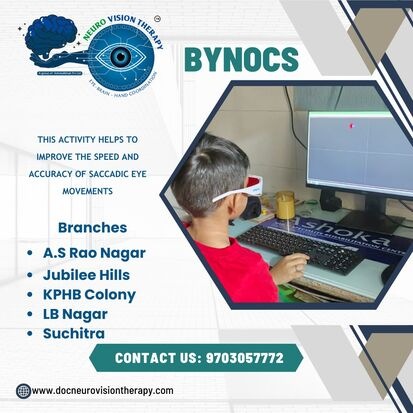
Neuro vision Clinic is a powerful tool for addressing a wide range of visual problems that can impact a child’s development and learning.
Neuro vision therapy is a specialized program designed to improve visual skills and processing in children. Unlike traditional eyeglasses or contact lenses, which primarily correct refractive errors like nearsightedness or farsightedness, vision therapy focuses on training the eyes and brain to work together (eye-brain-hand coordination) more effectively. This type of therapy addresses various visual problems that can impact a child’s learning, reading, and overall development.
Neuro vision Clinic is a powerful tool for addressing a wide range of visual problems that can impact a child’s development and learning. By providing a personalized, comprehensive approach to vision care, vision therapy can help children improve their visual skills and achieve better academic and life outcomes.
Our Services
Strabismus: It is commonly known as “crossed eyes” or “squint,” is a vision condition characterized by the misalignment of the eyes. In individuals with strabismus, the eyes may point in different directions, affecting their ability to focus and coordinate vision properly.
Amblyopia: It is commonly referred to as “lazy eye,” is a vision disorder that typically develops in early childhood. It occurs when one eye has significantly better visual acuity than the other, leading the brain to favor the stronger eye and suppress the input from the weaker eye. As a result, the weaker eye fails to develop normal vision, leading to reduced visual clarity and depth perception.
ADHD and Vision: Children experiencing vision difficulties may exhibit signs such as poor attention, limited self-control and/or hyperactivity. While these symptoms often lead to a diagnosis of ADHD, it’s crucial to consider that vision conditions could be the underlying cause of these behavioral challenges. Unfortunately, traditional vision screenings typically overlook the tests necessary to diagnose vision-related learning issues.
Concussion: It is a type of brain injury that occurs when a sudden blow or jolt to the head causes the brain to move rapidly within the skull. This movement can result in temporary disruption of normal brain function. Concussions can happen from a variety of causes, including sports-related injuries, falls, motor vehicle accidents, or physical altercations. Symptoms of a concussion can vary widely but may include headache, confusion, dizziness, nausea, sensitivity to light or noise, difficulty concentrating, memory problems, and changes in mood or behaviour.
Nystagmus: It is a vision condition characterized by rapid, involuntary, and repetitive eye movements. These movements can occur horizontally, vertically, or in a rotary (circular) pattern. Nystagmus can affect one or both eyes and may be present from birth (congenital) or develop later in life (acquired). Nystagmus can result in reduced vision, depth perception, and balance, depending on its severity and associated conditions.
Binocular Vision Disorders: It is type of vision condition characterized by difficulty coordinating the eyes to work together effectively when focusing on nearby objects. When convergence is impaired, individuals may experience symptoms such as eye strain, double vision, headaches, blurred vision, and difficulty concentrating on near tasks. Symptoms of a binocular vision disorders are headache, difficulty in reading, double vision, eye strain, feeling tired while reading.
Dyslexia: Dyslexia is a learning disorder that makes it hard for you to read, spell, and write. People who have it are often smart, but their brains have trouble connecting letters they see to the sounds those letters make.
© 2024 Crivva - Business Promotion. All rights reserved.